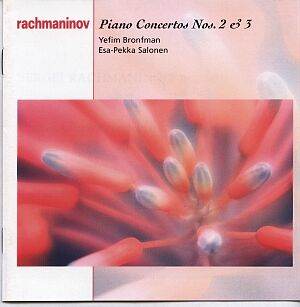Until recently, the all-time favourite Brief Encounter Concerto
used most often to be coupled with the Paganini Rhapsody, or
the shorter First or Fourth Concertos, giving you about an hour’s worth
of music. The slightly longer Third, on the other hand, often took up
a whole CD. Nowadays, since Shine brought it to a wider public
attention, the Third Concerto has been approaching the Second in popularity
– and rightly so! – and so this generous coupling of Nos 2 and
3 is the obvious one to market. It makes for an interesting (if emotionally
exhausting) programme, and offers unbeatable value, especially (as here)
at superbudget price.
I don’t recall hearing (or even coming across) these
performances before, but they most certainly compare with the best available.
Bronfman is a superb player. I first came across him as a sensitive
and supportive accompanist – a role which high-profile concert soloists
don’t always fulfil effectively – to Shlomo Mintz in the Prokofiev,
Ravel, Debussy and Franck Violin Sonatas. More recently, I’ve been enjoying
his new disc of Rachmaninov two-piano music, in which he is partnered
by Emanuel Ax: wonderful music-making from two musicians who not only
work well together as a team, but also exude individuality and personality.
The same is true here: Bronfman and Salonen are clearly
at one in their collaboration, and yet each obviously feels free to
allow his musical personality to boil over into the foreground, and
so offer us all manner of distinctive and memorable moments.
Bronfman’s playing is muscular and weighty: his fingerwork
has a percussive clarity and, even when confronted with handfuls of
notes (as in the ossia cadenza of No 3’s first movement), his
power and confidence seem never to diminish. And yet there are times
when everything quietens and relaxes unpredictably, in a way which seems
out of keeping with the scale of his playing elsewhere: shortly after
the recapitulated ‘big’ theme in No 2’s first movement, at 7' 31", Bronfman
suddenly holds right back, momentarily singing sotto voce over
the Philharmonia’s silky strings – uncalled for, you might argue, but
the effect is undoubtedly beguiling!
It is true that Salonen and his orchestra don’t have
nearly so important a role in the proceedings as they do in (say) the
Brahms Concertos. But, even so, these are no mere accompaniments. One
of the most enjoyable aspects of these performances is the way Salonen
brings out lines in the harmony which the orchestra (far more than the
piano) are able to sustain and carry forward: this does wonders for
creating momentum and excitement. And, time and time again, individual
voices within the ensemble contribute moments of real beauty: the violins’
playing at the end of No 2’s slow movement, for example, is nothing
less than divine!
Any misgivings? Not really. You may feel that Bronfman
tends to press on unrelentingly, and that he might relax more. And you
may find the recording a little brittle, rather than warm. But you might
be too swept along even to notice!
So, one hell of a disc: the pleasure-per-penny factor,
were we able to calculate such a thing, is definitely towards the top
of the scale.
Peter J Lawson


